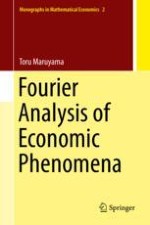2018 | OriginalPaper | Chapter
8. Fourier Analysis of Periodic Weakly Stationary Processes
Author : Toru Maruyama
Published in: Fourier Analysis of Economic Phenomena
Publisher: Springer Singapore
Activate our intelligent search to find suitable subject content or patents.
Select sections of text to find matching patents with Artificial Intelligence. powered by
Select sections of text to find additional relevant content using AI-assisted search. powered by

